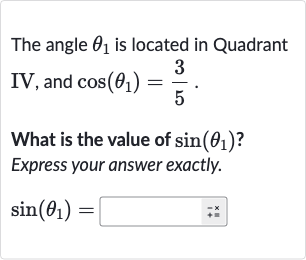Full solution
Q. The angle is located in Quadrant IV, and .What is the value of ? Express your answer exactly.
- Given Information: We are given that and that is in Quadrant IV. In Quadrant IV, cosine is positive and sine is negative. We can use the Pythagorean identity to find the value of .
- Solving for : First, we will solve for . We know that .
- Using Pythagorean Identity: Now, we use the Pythagorean identity to find .
- Finding : Next, we take the square root of both sides to find . Since is in Quadrant IV, we must take the negative square root because sine is negative in this quadrant.

